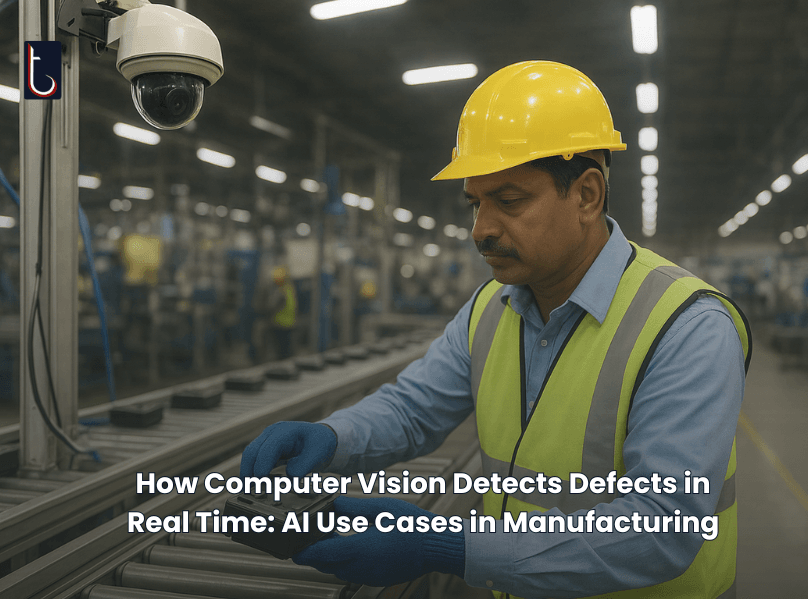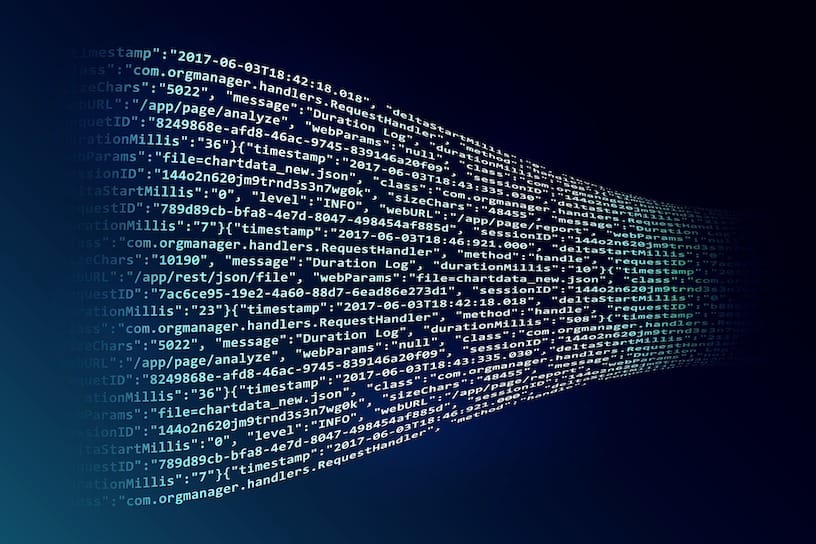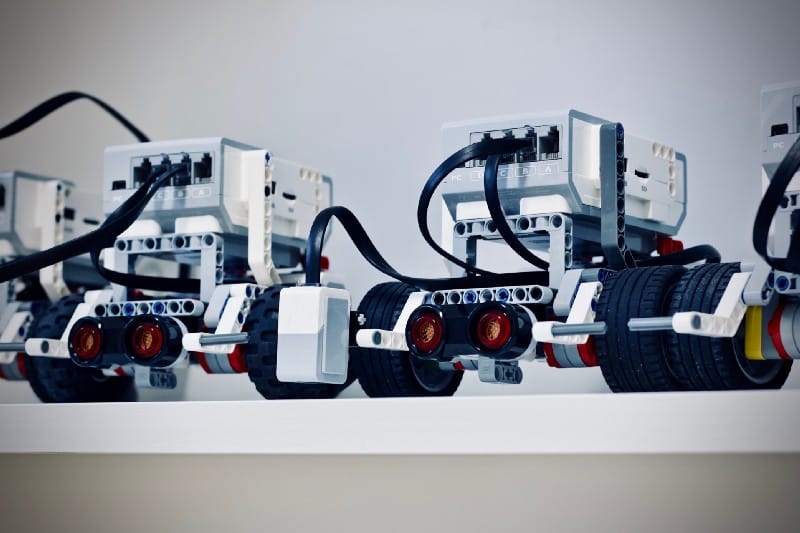Table of Contents
How Computer Vision Detects Defects in Real Time: AI Use Cases in Manufacturing

Introduction: The Shift Toward Automated Quality Control
Quality control has always been the backbone of manufacturing, but in today’s high-speed production environments, traditional inspection methods can’t keep up. Manual inspection is time-consuming, inconsistent, and often inaccurate under pressure. The solution lies in computer vision defect detection, where AI-powered cameras automatically inspect every product in real time – without fatigue or bias.
Manual inspection is time-consuming, inconsistent, and often inaccurate under pressure. The solution? Automating quality control using AI and computer vision services that can inspect every product, every second, without fatigue or bias.
Across industries, manufacturers are now deploying vision analytics solutions to detect surface defects, verify assembly accuracy, and ensure packaging quality automatically. These systems are redefining AI use cases in manufacturing, setting a new standard for speed and reliability on the shop floor.
The Problem with Manual Quality Inspection
For decades, human inspectors have been the last line of defense for quality. But as production lines accelerate, relying solely on human attention becomes unrealistic.
Common challenges include:
- Fatigue and inconsistency: Even skilled inspectors miss minor defects after hours of repetitive tasks.
- Limited throughput: Humans can only check a few products per second; AI can check hundreds.
- Subjectivity: What one operator considers a minor defect, another may flag as critical.
- Data gap: Manual inspection generates no useful analytics for process improvement.
In many manufacturing units, quality reporting is still a manual, paperwork-heavy process. Operators often log inspection data “just for compliance” rather than accuracy. To maintain smooth audits or keep upper management satisfied, teams may underreport defects or inflate performance metrics. This creates a false sense of quality stability, masking the real inefficiencies on the shop floor. Over time, these inaccurate reports lead to production losses, recurring defects, and flawed decision-making.
AI-based computer vision consulting services address all of these issues by bringing consistency, measurable data, and real-time alerts into the process. Unlike human-driven reports, vision systems provide transparent, traceable data that reflects the true state of production quality, helping management act on facts, not assumptions.
How AI and Computer Vision Automate Quality Control
Modern computer vision defect detection systems capture high-resolution images of every product on the line. AI and ML models then analyze these images to identify scratches, cracks, or missing parts within milliseconds, enabling consistent, 24/7 inspection at scale.
These visual inspection systems replace manual spot checks with continuous, automated analysis. The process typically follows four stages:
- Image Capture: High-resolution cameras are positioned along production lines to capture every product from multiple angles.
- Defect Detection: AI and ML models analyze each frame in real time to detect scratches, cracks, misalignments, or missing components.
- Classification & Response: The system identifies defect types and either alerts operators, triggers automatic rejection, or logs data for trend analysis.
- Feedback & Optimization: Over time, the AI refines its accuracy by learning from operator feedback and new defect examples.
The result: zero missed inspections, faster production flow, and reliable quality data feeding back into the production process.
Key AI Use Cases in Automated Quality Control
Automating QC with AI goes far beyond visual inspection. Some of the most powerful use cases of AI in manufacturing include:
- Surface defect detection: Identifying scratches, dents, or surface blemishes on metal, plastic, or glass parts.
- Assembly verification: Checking if parts are properly aligned, attached, or fastened.
- Label and print inspection: Ensuring correct label placement, color consistency, and barcode readability.
- Dimensional accuracy checks: Detecting deviations in product shape or size.
- Contamination control: Monitoring food, pharma, or packaging lines for unwanted particles or residue.
- Safety monitoring: Using computer vision to ensure workers wear proper safety gear and stay within safe zones.
Each of these examples can be customized to your product type, line speed, and defect tolerance level.
Why Automating Quality Control Outperforms Manual Inspection
Automated systems outperform manual QC not only in precision but also in operational intelligence.
Here’s what manufacturers typically gain:
Metric | Manual QC | Automated QC with AI |
Detection accuracy | 80-85% | 98-99% |
Products inspected per minute | <10 | 100-200+ |
Reporting reliability | Subjective | Data-driven |
Inspection consistency | Varies by operator | 24/7 uniformity |
Feedback loop | Manual and delayed | Instant and self-learning |
By implementing custom computer vision solutions, manufacturers can scale QC without scaling headcount – transforming inspection from a cost center into a competitive advantage.
Integrating Automated QC into Existing Systems
One misconception is that automation requires overhauling the production line. In reality, computer vision consulting services specialize in designing solutions that integrate seamlessly into existing setups.
Implementation typically involves:
- Assessing current inspection workflows and failure points
- Selecting the right camera hardware and lighting conditions
- Building and labeling image datasets
- Training and validating custom defect detection models
- Connecting results to MES, ERP, or dashboard systems
With proper integration, automated QC not only identifies defects but also feeds live insights to production managers, enabling faster decisions and continuous improvement.
The ROI of Automated Quality Control
Automating quality control isn’t just about speed – it’s about measurable business impact.
Consider a manufacturer that switches from manual inspection to a vision analytics solution powered by AI:
- Labor hours saved: Thousands annually due to reduced manual checks
- Reduced rework: Fewer defects escape to later stages of production
- Lower rejection rates: Early detection minimizes scrap and waste
- Improved customer trust: Consistent quality strengthens brand reputation
Many manufacturers see full ROI within 6-12 months after implementation. The system pays for itself through reduced rework, better throughput, and fewer customer returns.
According to a recent research by McKinsey & Company, manufacturers who automated quality checks in their factories saw a 90% improvement in defect detection.
Conclusion
Automating quality control is no longer a luxury – it’s a competitive necessity.
As manufacturers adopt computer vision defect detection across production lines, they gain not only accuracy but also real-time insights that help predict and prevent quality issues before they occur.
By combining defect detection, data transparency, and self-learning models, factories move from reactive to predictive quality management, building products right the first time, every time.
Frequently Asked Questions (FAQs)
1. How is AI used in the manufacturing industry today?
AI is used in manufacturing for automated quality inspection, worker efficiency tracking, predictive maintenance, production optimization, automated attendance and supply chain forecasting. From defect detection cameras to robotic vision systems, AI helps manufacturers achieve higher efficiency and lower error rates across operations.
2. What is computer vision in manufacturing?
Computer vision in manufacturing uses AI-powered cameras and algorithms to automatically inspect products, detect defects, and monitor production lines in real time. It replaces manual inspection with faster, more consistent, and data-driven quality control.
3. What are computer vision business solutions in manufacturing?
Computer vision business solutions combine AI algorithms, high-resolution cameras, and analytics dashboards to automate inspection, track defects, and analyze production trends. These solutions enable data-driven decision-making and continuous improvement across the manufacturing process.
4. How does computer vision detect defects in real time?
High-resolution cameras capture images of each product on the production line. AI and machine learning models then analyze these images to identify surface defects, assembly issues, or labeling errors within milliseconds. The system can trigger alerts, reject faulty items, or update dashboards automatically.
5. What is defect detection in manufacturing using computer vision?
Defect detection in manufacturing using computer vision involves deploying AI-powered cameras and algorithms to automatically identify surface flaws, dimensional errors, or assembly issues on production lines. This approach enables continuous, real-time quality inspection without human intervention.
6. Why is defect detection important in manufacturing?
Defect detection in manufacturing prevents defective products from reaching customers, reduces rework and scrap, and protects brand reputation. With AI and computer vision, manufacturers can maintain uniform quality standards while cutting inspection time and costs.
7. How accurate is defect detection in manufacturing with AI and computer vision?
AI-powered vision systems can reach up to 99% detection accuracy, far surpassing manual inspection. Their performance continues to improve over time as models learn from new defect samples and operator feedback.
If you’re ready to explore how custom computer vision solutions can transform your inspection processes, now is the time to start.
Connect with us at contact@biztechanalytics.com or visit our website to know more.


